
Walton Hall is a country house in Walton near Wakefield in West Yorkshire, England. It was built on the site of a former moated medieval hall in the Palladian style in 1767 on an island in a 26-acre (11 ha) lake. It was the ancestral home of the naturalist and traveller Charles Waterton, who made Walton Hall into the world's first wildfowl and nature reserve.

West Bretton is a village and civil parish near Wakefield, West Yorkshire, England. It lies close to junction 38 of the M1 motorway at Haigh. It has a population of 546, reducing to 459 at the 2011 Census.

Bretton Hall is a country house in West Bretton near Wakefield, West Yorkshire, England. It housed Bretton Hall College from 1949 until 2001 and was a campus of the University of Leeds (2001–2007). It is a Grade II* listed building.

Wakefield is a cathedral city in West Yorkshire, England located on the River Calder. The city had a population of 109,766 in the 2021 census, up from 99,251 in the 2011 census. The city is the administrative centre of the wider Metropolitan Borough of Wakefield, which had a 2021 population of 353,802, the 25th most populous district in England. It is part of the West Yorkshire Built-up Area and the Yorkshire and The Humber region.

Barnsley is a market town in South Yorkshire, England. It is the main settlement of the Metropolitan Borough of Barnsley and the fourth largest settlement in South Yorkshire. The town's population was 96,888 in 2021, while the wider borough had a population of 244,600 in the 2021 census.
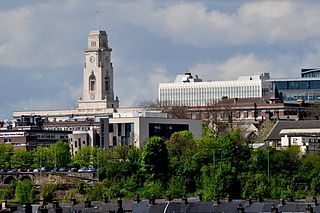
The Metropolitan Borough of Barnsley is a metropolitan borough in South Yorkshire, England; the main settlement is Barnsley and other notable towns include Penistone, Wombwell and Hoyland.

The Yorkshire Sculpture Park (YSP) is an art gallery, with both open-air and indoor exhibition spaces, in West Bretton, Wakefield, in West Yorkshire, England. It shows work by British and international artists, including Henry Moore and Barbara Hepworth. The sculpture park occupies the 500-acre (200-hectare) parkland of Bretton Hall.

Halifax Minster is the minster church of Halifax, Calderdale, West Yorkshire, England. The church is dedicated to St John the Baptist. The parish church of the town, it was granted minster status in 2009. Halifax Minster is one of three churches in the county of West Yorkshire to be given this honorific title; the other two are Dewsbury Minster and Leeds Minster.

Bretton Hall College of Education was a higher education college in West Bretton in the West Riding of Yorkshire, England. It opened as a teacher training college in 1949 with awards from the University of Leeds. The college merged with the University of Leeds in 2001 and the campus closed in 2007.

John Carr (1723–1807) was a prolific English architect, best known for Buxton Crescent in Derbyshire and Harewood House in West Yorkshire. Much of his work was in the Palladian style. In his day he was considered to be the leading architect in the north of England.

Silkstone is a village and civil parish in the Metropolitan Borough of Barnsley in South Yorkshire, England. It is situated in the foothills of the Pennines, between the towns of Barnsley and Penistone. The parish includes the village of Silkstone Common. At the 2001 census it had a population of 2,954, increasing to 3,153 at the 2011 Census.
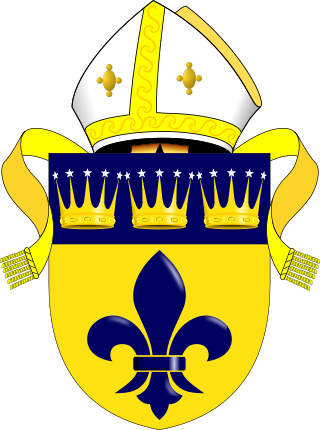
The Diocese of Wakefield is a former Church of England diocese based in Wakefield in West Yorkshire, covering Wakefield, Barnsley, Kirklees and Calderdale. The cathedral was Wakefield Cathedral and the bishop was the diocesan Bishop of Wakefield.

Altofts is a village in West Yorkshire, England. It lies 5 miles (8 km) north-east from the centre of Wakefield and less than 1 mile (1.6 km) north-west of Normanton. The M62 runs close to the village to the north-east, and the Aire and Calder Navigation to the north-west.

Woolley Hall is a country house in Woolley, West Yorkshire, England. It is a Grade II* listed building.

The Chantry Chapel of St Mary the Virgin is a chantry chapel in Wakefield, West Yorkshire, England, and is designated a Grade I Listed building by English Heritage. It is located south of the city centre on the medieval Chantry Bridge over the River Calder. It is the only survivor of four chantries in Wakefield and the oldest and most ornate of the surviving bridge chapels in England. Others are at St Ives (Cambridgeshire), Rotherham, Derby and Bradford-on-Avon. The chapel has had three west fronts, the original medieval façade having been removed to Kettlethorpe Hall in 1832. The medieval bridge is a scheduled ancient monument.

The Old Holy Trinity Church is a redundant Anglican church in the village of Wentworth, South Yorkshire, England. It is partly in ruins, and stands close to a newer church also dedicated to the Holy Trinity. The old church is recorded in the National Heritage List for England as a designated Grade II* listed building, and is in the care of the Churches Conservation Trust.
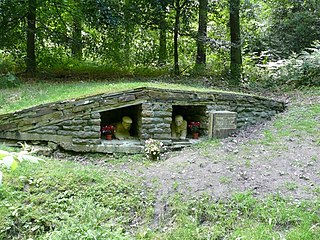
Huskar Pit was a coal mine on the South Yorkshire Coalfield, sunk to work the Silkstone seam. It was located in Nabs Wood, outside the village of Silkstone Common, in the then West Riding of Yorkshire. It was connected to the Barnsley Canal by the Silkstone Waggonway. Huskar was the scene of a notorious pit disaster in 4 July 1838.
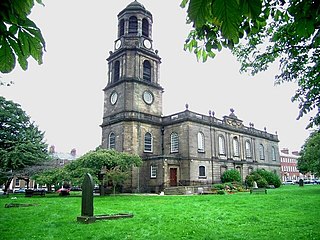
The Church of Saint John the Baptist in Wakefield, West Yorkshire, England is an active Anglican parish church in the archdeaconry of Wakefield and the Diocese of Wakefield. The church is Grade II* listed and has been since 30 March 1971. St John's is the smaller of the Anglican churches in Wakefield City Centre, the larger being Wakefield Cathedral.
West Bretton is a civil parish in the metropolitan borough of the City of Wakefield, West Yorkshire, England. The parish contains 40 listed buildings that are recorded in the National Heritage List for England. Of these, four are listed at Grade II*, the middle of the three grades, and the others are at Grade II, the lowest grade. The parish contains the village of West Bretton and the surrounding area, much of which is occupied by Bretton Park, the grounds of the country house, Bretton Hall. The hall is listed, together with a number of associated buildings, and structures in the park. The other listed buildings include houses, cottages and associated structures, farmhouses and farm buildings, a well head and a niche for a water pump, a church and associated structures, a school, a former mill building, a sculpture, and four mileposts.
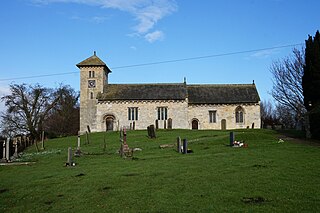
St John the Baptist Church is the parish church of Healaugh, a village west of York and north of Tadcaster in North Yorkshire, in England.



















